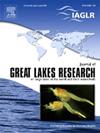Biogeographic barriers are differentially permeable based on traits: Movement of hypoxia tolerant mormyrid fish in the Lake Victoria basin
IF 2.5
3区 环境科学与生态学
Q3 ENVIRONMENTAL SCIENCES
引用次数: 0
Abstract
Lake Nabugabo is a small satellite lake separated from Lake Victoria by hypoxic swamps that impose a biogeographic barrier to fish assemblages. Some species occur exclusively in Nabugabo while others show high differentiation across this barrier, yet air-breathing fishes show nearly zero genetic differentiation between the two lakes. We hypothesize that hypoxia-tolerant fishes, unlike other non-air-breathing species, would have similarly low genetic differentiation across the barrier. We used pooled RAD-seq to examine the degree of genetic differentiation in two species of non-air-breathing but hypoxia-tolerant mormyrid fishes, Marcusenius victoriae and Petrocephalus degeni. Other non-air-breathing fishes have been shown to have FST values as low as 0.05 but mostly between 0.10 and 0.20; however, we discovered that the genetic differentiation in our focal species was very low, with FST values between 0.02 and 0.04, making them much more comparable to air-breathing fishes with FST values of near zero. We conclude that this and other analogous barriers should be understood as differentially permeable depending on the traits of the organisms crossing them, such as hypoxia tolerance in this case.
生物地理屏障的可渗透性差异基于特征:维多利亚湖盆地耐缺氧mormyrid鱼的运动
纳布加博湖是一个小卫星湖,与维多利亚湖隔着缺氧沼泽,对鱼类的聚集形成了生物地理屏障。一些物种只出现在纳布加博,而另一些物种则在这一屏障上表现出高度分化,然而在两个湖泊之间,呼吸空气的鱼类几乎没有遗传分化。我们假设耐缺氧的鱼类,不像其他不呼吸空气的物种,在屏障上也有类似的低遗传分化。本文采用聚合RAD-seq方法对两种不呼吸空气但耐缺氧的mormyrid鱼类Marcusenius victoriae和Petrocephalus degeni的遗传分化程度进行了研究。其他非呼吸空气鱼类的FST值低至0.05,但大多在0.10至0.20之间;然而,我们发现我们的焦点物种的遗传分化非常低,FST值在0.02到0.04之间,这使它们与FST值接近于零的空气呼吸鱼类更具有可比性。我们的结论是,这种屏障和其他类似的屏障应该被理解为不同的渗透性,这取决于穿过它们的生物的特征,比如在这种情况下的耐缺氧性。
本文章由计算机程序翻译,如有差异,请以英文原文为准。
求助全文
约1分钟内获得全文
求助全文
来源期刊

Journal of Great Lakes Research
生物-海洋与淡水生物学
CiteScore
5.10
自引率
13.60%
发文量
178
审稿时长
6 months
期刊介绍:
Published six times per year, the Journal of Great Lakes Research is multidisciplinary in its coverage, publishing manuscripts on a wide range of theoretical and applied topics in the natural science fields of biology, chemistry, physics, geology, as well as social sciences of the large lakes of the world and their watersheds. Large lakes generally are considered as those lakes which have a mean surface area of >500 km2 (see Herdendorf, C.E. 1982. Large lakes of the world. J. Great Lakes Res. 8:379-412, for examples), although smaller lakes may be considered, especially if they are very deep. We also welcome contributions on saline lakes and research on estuarine waters where the results have application to large lakes.
 求助内容:
求助内容: 应助结果提醒方式:
应助结果提醒方式:


